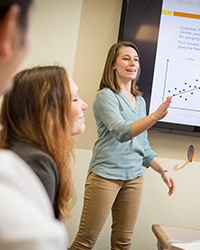
For reasons both practical and emotional, people tend to do most of their charitable giving towards the end of the year. Whether we feel inspired by the generous spirit of the holiday season or we’re looking to round out our year’s donations for tax purposes, not-for-profit organizations largely supported by donations are likely experiencing their busiest time of the year right now, in the home stretch of the final quarter.
What steps can donors take to feel confident that their money is being put to good use? Or when might it be more useful to donate time? We asked Willamette University MBA’s Dean and JELD-WEN Professor of Free Enterprise Debra Ringold and Executive Professor Geoff Guilfoy some questions that may be weighing on your mind as you consider how and to whom you should give back this year.
Time vs. Money
The decision whether to donate time or money (or both) to an organization has as much to do with the nonprofit’s priorities as it does with the donor’s preference or ability.
“Not-for-profits have to be disciplined in prioritizing what they need in order to achieve their mission,” said Ringold. “Donors have to respect those priorities if they want the mission fulfilled.”
If money is your gift of choice, the question of whether to give a large one-time gift or small regular gifts is again a question of what the donor is able to give and what the not-for-profit needs. While large, unrestricted gifts provide flexibility in investing decisions, smaller disbursements “allow for certainty of cash flow,” Ringold said.

If you’re more inclined to give a one-time gift for the holidays, seek out a few not-for-profits whose missions you support, and see if any of them are actively raising funds for a special capital campaign. According to Guilfoy, your donations to these types of efforts will help ensure that the organization “can move ahead with the project faster.”
However, donation of time is always needed and just as welcomed by all not-for-profits, added Guilfoy. Certainly, for a student, “it is probably much easier to give volunteer time versus money,” he said.
“(Willamette University MBA) gives a lot of donated time to nonprofits in its PACE program and in courses like my Not-for-Profit Governance and Management course where students complete a project for a nonprofit,” said Guilfoy. “I know this is highly appreciated in the nonprofit community and we regularly hear how much they appreciate it.”
Ethical Decisions
It’s no secret that large not-for-profit organizations have been the subject of scrutiny by the media and the public, especially when it comes to claims of donations being used mostly for administrative overhead, including high-paid executives. A simple Google search yields pages of salacious “nonprofits behaving badly” listicles.

But high salaries are not always necessarily a sound reason to not give to a particular charity. Ringold stressed that large, sophisticated not-for-profits deserve to be managed just as effectively and competitively as for-profit corporations, and in order to achieve this, “professional managers must be hired and compensated appropriately.”
“I’ve always wondered why people think great managers in the not-for-profit sector ought to make less than great managers in the for-profit sector, especially when the work of not-for-profits is arguably more important,” she added.
Ultimately, while all donations are at the discretion of the donor, the not-for-profits most worthy of our support are the ones that perform excellently, that make an actual measurable impact — regardless of the size or status of the organization.
“People should think about what causes matter most to them and seek out organizations that share the same priorities,” said Ringold.
Resources for strategic giving
There are several resources online that can help you better understand strategies and trends around charitable giving, as well as investigate nonprofits you are considering supporting. Here’s a small list of resources that we find helpful:

